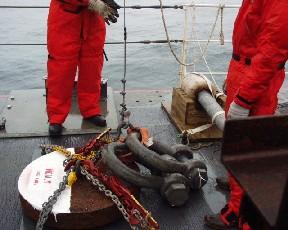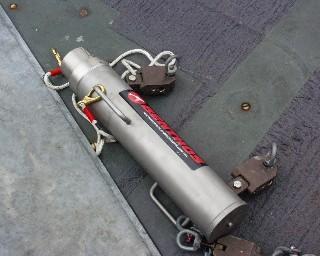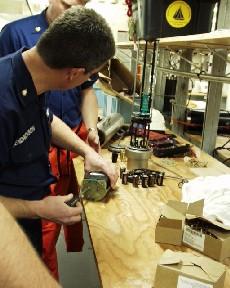3 June, 2000
The Ping Puzzle
June 3, Saturday
"Ping!"
That's the sound scientists were hoping to hear as they lowered the pinger
over the side of the ship. When the pinger is in the water, it can tell
scientists how far it is from the bottom of the ocean.
It works like this. The pinger is attached to a cable (thick wire) which is
lowered down in the water by a winch. The winch operators slowly let the
cable out, and heavy weights pull the pinger down to the bottom.
All this time, the pinger is making a pinging sound. It can be heard
throughout the ship. Sensors on the underside of the ship record when each
ping is emitted. They also record the time that the ping's echo returns from
the bottom of the ocean. Because scientists know how fast sound travels
through water, they can calculate how far away something is by knowing how
long it takes the "ping" and its echo to be "heard" by the sensors.
Think of it like this. You are standing facing a cliff that is across the
lake from you. You shout as loudly as you can: "HELLO!" Your ear hears the
sound almost immediately. Four seconds later, you hear the echo: "HELLO!" If
you know that sound travels 300 meters per second through air, you can
figure out how far away the cliff is. Go ahead, try it. The answer is at the
end of this entry.
Pingers are often attached to scientific equipment that is being lowered to
the bottom of the ocean. With the help of the pinger scientists lowering
this equipment can keep it from hitting the ocean floor. Does this always
work? Click on Janice’s page to learn about what could happen!
Janice’s Entry
Today.
By the way, did you know that sound travels through water five times faster
than it does through air? That's because the molecules in water are packed
more closely together than they are in air.
ANSWER TO THE ECHO QUESTION:
The cliff is 600 meters away from you. It takes 2 seconds for the shout to
travel across the lake to the cliff, and 2 more seconds to get back to you.
DAILY DATA LOG (6/03/00):
Air Temperature: 0 degrees C / 32 degrees F
Clear skies, sunny
Latitude 51N
Longitude 52W

These weights are attached to the pinger to help it sink in the water.

This is a pinger.

The pinger uses batteries to make a pinging sound tht can be "heard" by a transducer.

Marine Science Technicians (MST's) attach the pinger to a cable to lower it off the stern of the ship.
Contact the TEA in the field at
.
If you cannot connect through your browser, copy the
TEA's e-mail address in the "To:" line of
your favorite e-mail package.
|
